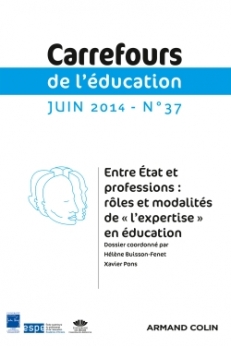
Carrefours de l'éducation n° 37 (1/2014)
Pour acheter ce numéro, contactez-nous
Recevez les numéros de l'année en cours et accédez à l'intégralité des articles en ligne.
Au sein d’un cadre théorique de sociologie de l’action publique, les auteurs analysent l’implantation d’un instrument de politique éducative auprès de 17 directeurs de centre de formation professionnelle (CFP) montréalais, interrogés lors d’entretiens semi-directifs. Le Ministère de l’éducation du Québec demande que le nombre des jeunes de moins de 20 ans augmente en FP : cette prescription se déploie dans un contexte de nouvelle gouvernance où les responsables locaux sont redevables de leurs actions en termes d’amélioration d’indicateurs statistiques. L’analyse se concentre sur la manière dont la prescription perturbe les représentations collectives. La focalisation statistique sur la question des jeunes tend à bouleverser l’image positive qui s’était progressivement construite dans le milieu. Le déplacement de regard produit un effet d’anamorphose contribuant à montrer ce qui se cachait et à rendre flou le tableau d’ensemble d’un secteur de formation luttant depuis longtemps pour une reconnaissance de sa valeur et de sa fonction.
Working within the framework of the sociology of public action, the authors analyse the implementation of an educational policy tool with 17 directors of professional training centres in Montreal, interviewed through semi-directive questionnaires. Quebec’s Education minister wants to see the number of young people in vocational teaching go up: this request is being implemented within the context of new modes of governance whereby local authorities are accountable for their actions in terms of the improvement in various statistical indicators (of economic health). The analysis focuses on the way the minister’s prescription disturbs collective interpretations. Statistical focus on the issue of the young people tends to transform the positive image, which had gradually developed in this environment. The displacement of the point of view produces the same effect as an anamorphosis, contributing to showing what was hidden and to making the description of an area of training and development, which has long been fighting for recognition of its value and function, rather vague.